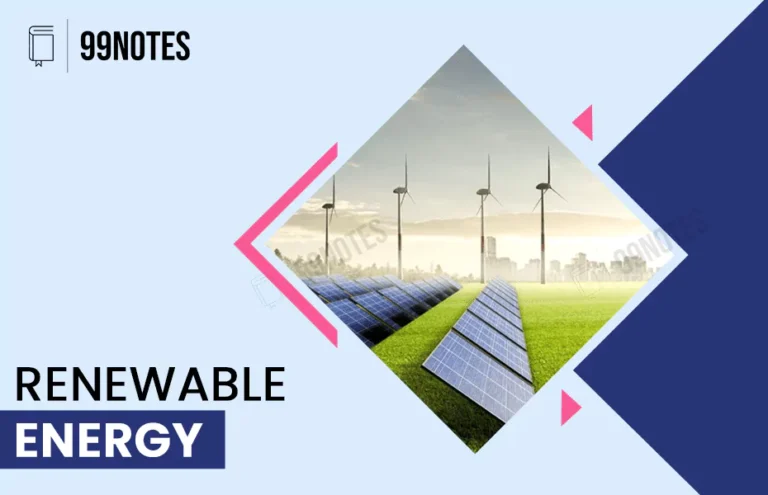Non Renewable Energy Infrastructure: Sources, Advantages and Disadvantages- Complete Notes for UPSC
Non Renewable Energy
Non-renewable energy is derived from natural sources that cannot be regenerated and readily replaced by natural means quickly to keep up with consumption.
The non-renewable energy sources are – coal, natural gas, petroleum oils and others.
- Nuclear energy is also considered a non-renewable energy source because there is a limited uranium supply in the earth’s crust.
Status of Energy Requirements of India:
- As per the India Energy Outlook Report 2021 by IEA, India will overtake European Union as the third-largest energy consumer in the world by 2030.
- India is the fourth largest energy consumer behind the USA, China and the EU.
- Despite a shift towards renewable energy resources, rising oil demand could double India’s oil import bill to USD 181 billion in 2030.
- Dependence on oil imports: Taking into account both the import of crude oil and the export of oil products – an increase of more than 90% by 2040 from the current 75%as domestic consumption is expected.
- Diesel demand in India is desired to double to 163 MT by 2030.
- The primary energy consumption is expected to double as the Gross domestic product is expected to reach 8.6 trillion USD by 2040.
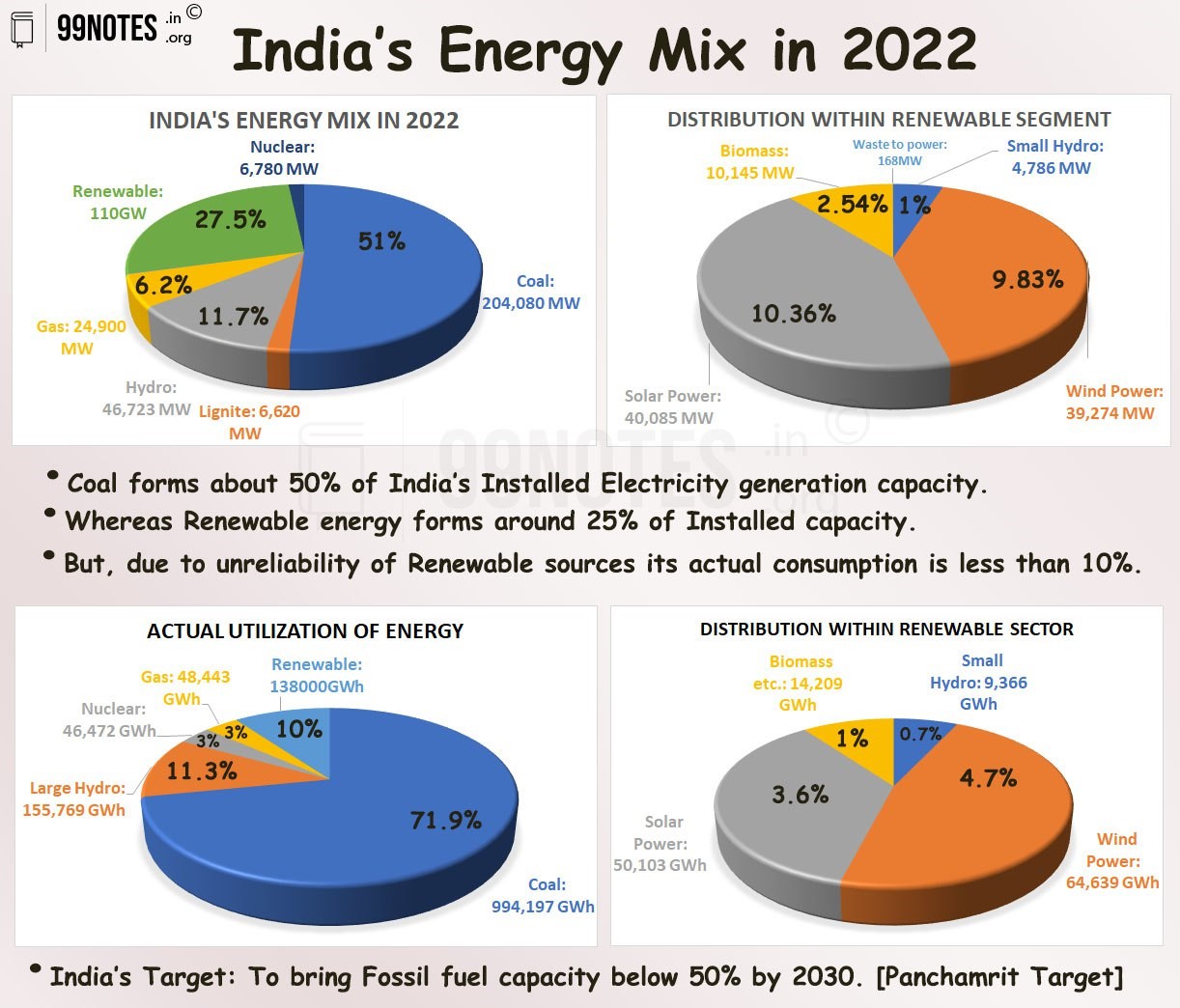
Current Scenario:
- In 2020, India used 77% fossil fuels for its electricity generation, of which 72.5% came from coal, 4.2% from natural gas, and 0.3% from oil.
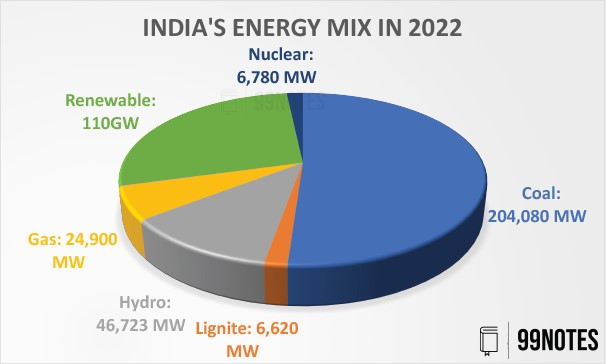
Advantages of Non-renewable Energy:
- Non-renewable energy resources have high energy potential. For example, fossil fuel resources such as coal, natural gas, and oil produce more energy than renewable energy resources like solar and wind.
- The ample availability of these resources provides a tremendous economic opportunity. Moreover, a country can profit by mining these resources for export and selling them for commercial activities.
- Cost-effectiveness: Presently, energy generation from non-renewable resources is much cheaper and cost-effective than renewable energy resources such as solar.
- Technology development: With better and ongoing innovations in the energy sector, non-renewable energy resources are getting more competitive and lucrative globally.
- Many of the non-renewal energy resources are easy to store and transport.
- Extraction, transportation, refining, and energy generation provide job opportunities for many people. Hence non-renewable energy sector provides a livelihood for them.
- Driving economic growth: Energy requirements of many developing and least developed nations are proliferating. Renewable energy solely will not be sufficient to meet this growing demand. Hence it becomes essential to generate power from non-renewable energy resources to keep up the pace of economic growth.
- Easy-to-use nature of these resources makes them preferable to renewable energy resources in certain situations.
- Huge installed capacity: Countries like India and China have substantial thermal power plants and are dependent on this energy for their needs. It is not possible to shift towards renewable energy in a short period of time.
Despite these advantages, the world is gradually shifting towards renewable energy resources. The reasons for this shift are mentioned below:
Disadvantages of Non-Renewable Energy:
- Environmental damage:
- Many greenhouse gases like nitrogen oxide and carbon dioxide are released into the atmosphere while burning fossil fuels like coal, petroleum, natural gas and so on. This carbon emission is one of the main reasons for global warming.
- Oxides of sulphur and nitrogen, released during fossil fuel burning, can cause acid rain. Acid rain can be very harmful to wildlife as well as human beings.
- The emission of gases from the burning of fossil fuels leads to the depletion of the ozone layer.
- Risk to human life and health concerns:
- Emissions such as carbon monoxide can cause respiratory problems in human beings, as highlighted by Ambient Air Quality Index by WHO.
- Workers working in coal mines and oil drills are more prone to health risks and accidental deaths.
- Time-consuming process: Mining coal, extracting onshore and offshore oil, refining, and installing drills require significant investments and are very time-consuming.
- Gradually diminishing: Since non-renewable energy resources such as coal take billions of years to form, the haphazard use of these resources is causing them to vanish from the earth’s crust.
- Transportation of fossil fuels through ships can cause accidents and oil spills on the sea’s surface. This can be very detrimental to marine life.
- Industrial Accidents associated with non-renewable energy, such as nuclear meltdowns, pipeline leaks, and spillage of toxic gases, cause harmful effects on human life and the environment.
- Economic burden: Countries like India heavily depend on exported fossil fuels for their energy requirements. Highly volatile prices and availability of these fossil fuels burden the exchequer.
- Shaping Geo-political dynamic: Over the last century, sovereign rights over these resources have been one of the most contentious issues among different countries.
- High associated transportation, storage, and safety costs make them viable at certain times.
- Decreasing and ageing wells: There has not been a significant discovery of oil in India in recent times. As a result, there is no more easy gas and oil availability in India.
- Import dependency: Approximately 85% of the oil demand is met through imported oil in India. However, this leaves India at the mercy of other nations for its energy security, as witnessed during the USA – Iran conflict.
- Lack of overseas interest: Foreign corporations and companies’ interest in oil extraction in India has been poor.
- Lack of private participation: Owing to cumbersome clearance procedures, lack of handheld government support, and easy credit availability – private participation in this sector is poor. Most of the industry is the monopoly of two state-owned companies- ONGC and Oil India.
Non-renewable Energy Infrastructure In India and Government Projects:

Thermal power capacity:
- More than 50% of generated electricity in India comes from thermal power plants.
- NTPC is the largest thermal power generating unit in India.
- The Vindhyachal thermal power Station (Madhya Pradesh)is the most prominent thermal power plant in the country at present, with a capacity of 4760 MW.
- While Mundra Thermal power station in Gujarat is India’s second-largest thermal power plant.
Coal exploration in India:
- Gondwana coal makes up about 98% of the total coal reserves in India, while the remaining are tertiary coalfields.
- Dhanbad and Giridih are one of the oldest and richest coal mines in India. Giridih ( Karbhari coalfield) gives the finest coking coal in India for metallurgical purposes.
- Apart from this – Raniganj, Jharsuguda, Singrauli, Nayveli, and Satpura coalfields in central India provide much-needed coal for thermal power plants in India.
- The government has recently highlighted its commitment to increasing coal production through PPP models.
Natural gas and oil exploration:
- The natural gas industry in India commenced in the 1960s with the discovery of natural gas in Assam and Mumbai High.
- As of 2022, India’s the third largest oil consumer in the world.
- The government has put forth several policies for expediting oil and gas exploration. The government has allowed 100% FDI in natural gas, petroleum products, refinery etc.
- The FDI limit for public sector refining projects has been increased to 49% without diluting domestic equity in PSUs.
- The industry is expected to attract USD 25 billion in the current FY.
- India’s crude oil production in 2022 stood at approximately 30 MMT.
- With a capacity of approximately 250 MMT, India is the second largest refiner in Asia, behind China. Further, India plans to double its refining capacity in the coming 10 years to meet its domestic requirements and tap export potential.
- Import Dependence: For the year 2022–23, the oil import dependence was about 85%, with Russia, Saudi Arabia and Iraq being the top countries for oil import.
- Oil exports from India: India has been the net exporter of petroleum products since the 2000s. India witnessed a sharp rise in oil exports due to Russia – Ukraine conflict in the last year. The oil exports increased by 12.5%, while the petroleum products exports increased by almost 70%(economic survey 2023).
- One Nation One Gas Grid: The government has targeted increasing the pipeline coverage by approximately 60% to 34,500 km by 2025. All the states are expected to be connected by a trunk national pipeline network by 2027.
- Government initiatives:
- In 2022, the government changed the biofuel policy with a target of 20% ethanol blending in petrol.
- Also, the government announced its intentions to double exploration areas of oil and gas to 1 million sq. Km to fulfil its domestic requirements and export.
- In 2021, the Indian government approved projects worth one lakh crore in northeast India. These projects are expected to complete by 2025.
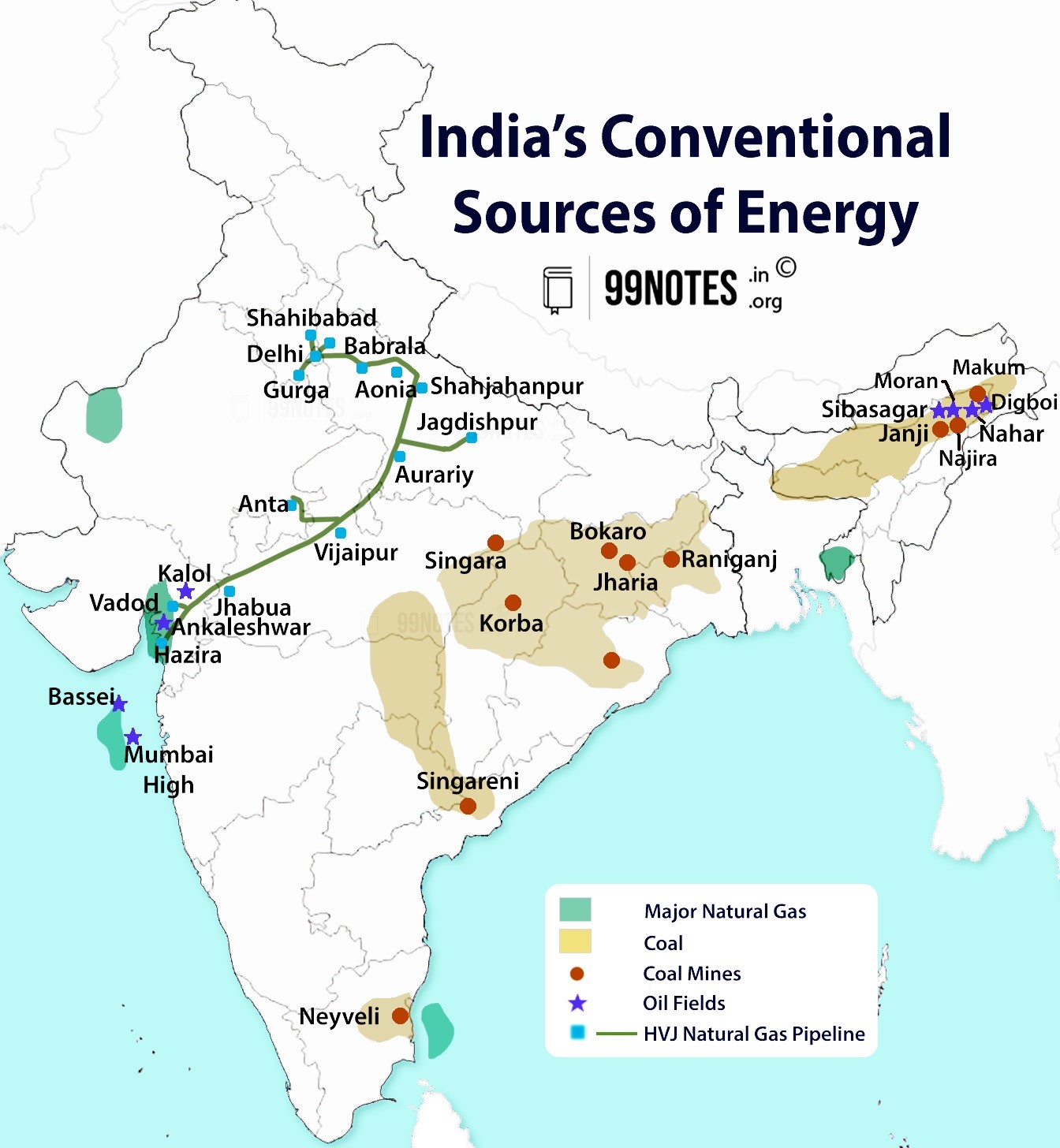
Nuclear Energy:
Nuclear power is the 5 th largest source of electricity after coal, gas, hydroelectricity and wind power in India.
Advantages of nuclear energy:
- Production of a large amount of energy can serve the rapidly growing energy demand of our country.
- Nuclear energy is less like it is affected by external conditions.
- One of the most stirring power sources available at the moment.
- Free from carbon emissions such as carbon dioxide, carbon monoxide, nitrous oxide etc.
- Nuclear energy is a reliable power source.
- It can be helpful in a transitory phase where India is trying to tap its renewable energy potential.
- The expansion of nuclear power capacity will help the country’s energy transition to meet the net zero economy goal.
- Local job creation.
Challenges to nuclear energy:
- Issues with the disposal and transportation of nuclear waste.
- Thermal pollution and environmental hazard.
- Contamination of environmental constituents such as soil, water etc.
- High initial costs of construction of nuclear power project and high maintenance cost.
- Issues with the reactor safety.
- Limited availability of domestic uranium for use in reactors. Hence dependency on other nations.
- The Chornobyl incident shows the possibility of accidents that can cause enormous damage.
- Opposition from the public: A protest was seen in the Jaitapur nuclear power project due to a lack of awareness.
- International sanctions: As India is not a signatory to Non-Proliferation Treaty (NPT), it limits India’s accessibility to better nuclear technology and fuel availability.
Status of nuclear energy in India:
- Nuclear energy is India’s fifth most significant energy source, contributing approximately 3% to electricity generation.
- India currently operates 22 nuclear reactors, producing 6780 MW of energy.
- Of these nuclear power reactors, 18 are PHWRs, while 4 are LWRs.
- Those nuclear power reactors under execution or accorded administrative approval and financial sanction will increase this capacity to 22480 MW by 2031.

Conclusion:
Although India has reiterated its commitment towards electricity generation from renewable power resources time and again, considering the economic costs associated and the need for allied infrastructure – it can be said that non-renewable energy will dominate the energy mix of India for at least some years. The sudden shift towards green alternatives seems complicated despite the environmental issues associated with non-renewable energy. Hence with measured investments in the renewable energy sector while reducing its dependence on fossil fuels – India can achieve its COP26 targets sustainably.

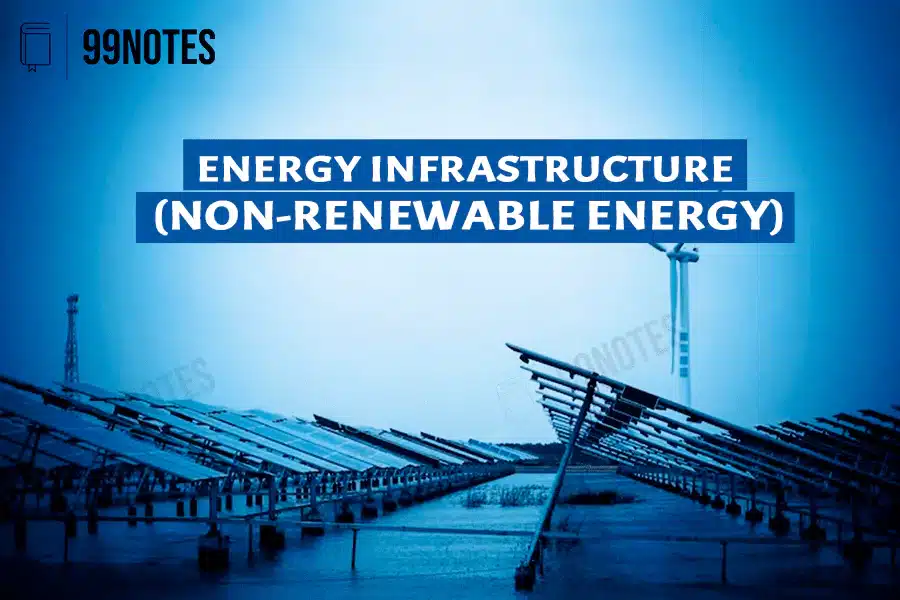


![What Is Social Infrastructure: Meaning, Importance &Amp; Challenges [Upsc Notes] | Updated July 27, 2024 What Is Social Infrastructure: Meaning, Importance & Challenges [Upsc Notes]](https://99notes.in/wp-content/uploads/2023/05/social-infrastructure-99notes-upsc-1-768x512.webp)


